KUALA LUMPUR, Feb 24 – Despite the continuation of Covid-19 lockdowns in 2021, Malaysia reported higher out-of-pocket (OOP) expenses for the year, with spending on inpatient services and pharmaceuticals rising above pre-pandemic levels.
The country recorded an annual 9 per cent jump in OOP spending at RM24.6 billion in 2021 versus RM22.6 billion in 2020. The latest figure also surpassed RM22.39 billion in 2019, according to the Ministry of Health’s (MOH) Malaysia National Health Accounts (MNHA) presentation last November 10.
Although expenditure on outpatient services continued to dominate OOP spending at RM9.98 billion (up 8.3 per cent) in 2021, pharmaceuticals and inpatient services expenditure saw the highest percentage increases during the year at 15.3 per cent and 12.5 per cent.
OOP spending on inpatient services and pharmaceuticals in 2021 at RM6.06 billion and RM3.9 billion respectively had also exceeded pre-pandemic levels.
OOP spending on inpatient services and pharmaceuticals in 2021 suggests what could be a one-off dramatic upswing, possibly due to the backlog of non-Covid procedures. The OOP figures for inpatient services and pharmaceuticals in 2019 were RM5.3 billion and RM3.29 billion respectively.
CodeBlue’s report on days’ long stranding of patients in Raja Permaisuri Bainun Hospital’s (HRPB) emergency department cited medical officers as saying that most of the critically ill patients coming into the ED are presenting with advanced non-communicable diseases (NCDs) — such as heart disease, kidney failure, and stroke — following the disruption of care during two years of Covid lockdowns.
Meanwhile, OOP spending also increased in other areas in 2021, including on medical appliances and non-durable goods (up 9.3 per cent year-on-year to RM848 million), traditional, complementary and alternative medicine (TCAM) (up 8.8 per cent to RM518 million), and other functions (up 2.3 per cent to RM1.8 billion).
The only decline in OOP spending was in education and training, which fell 5.5 per cent during the year to RM1.5 billion.
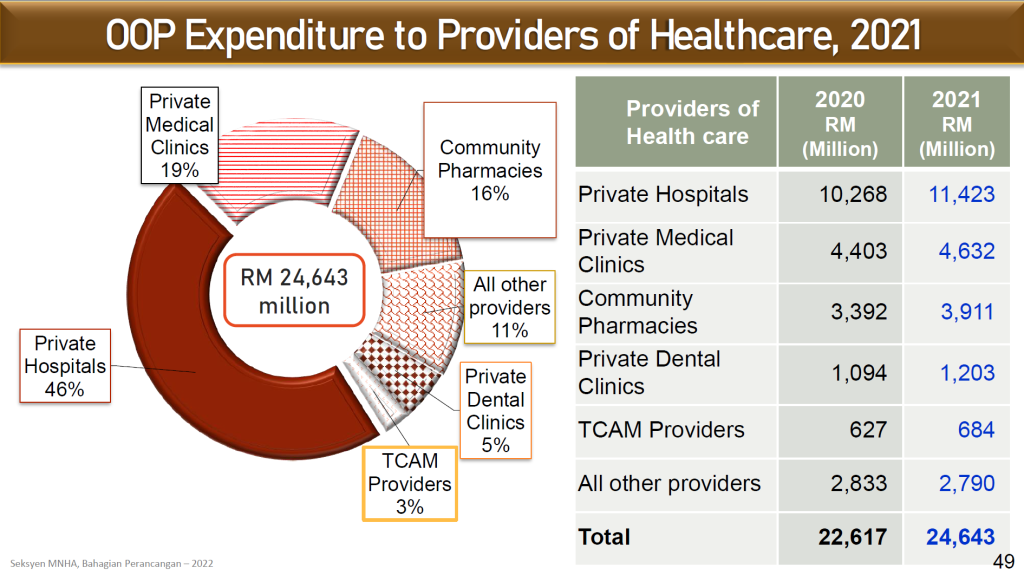
Out-of-pocket (OOP) expenditure to providers of health care in 2021. Graphic by MOH’s Malaysia National Health Accounts (MNHA) presentation on November 10, 2022.
Private hospitals were the main beneficiaries of OOP spending in 2021, making up 46 per cent of OOP expenditure at RM11.42 billion – up 11.2 per cent from RM10.3 billion in 2020.
This is followed by private medical clinics where OOP spending rose 5.2 per cent to RM4.6 billion, community pharmacies (up 15.3 per cent to RM3.9 billion), private dental clinics (up nearly 10 per cent to RM1.2 billion), and TCAM providers (up 9 per cent to RM684 million).
Other health care providers reported a 1.5 decline at RM2.79 billion compared to 2020.
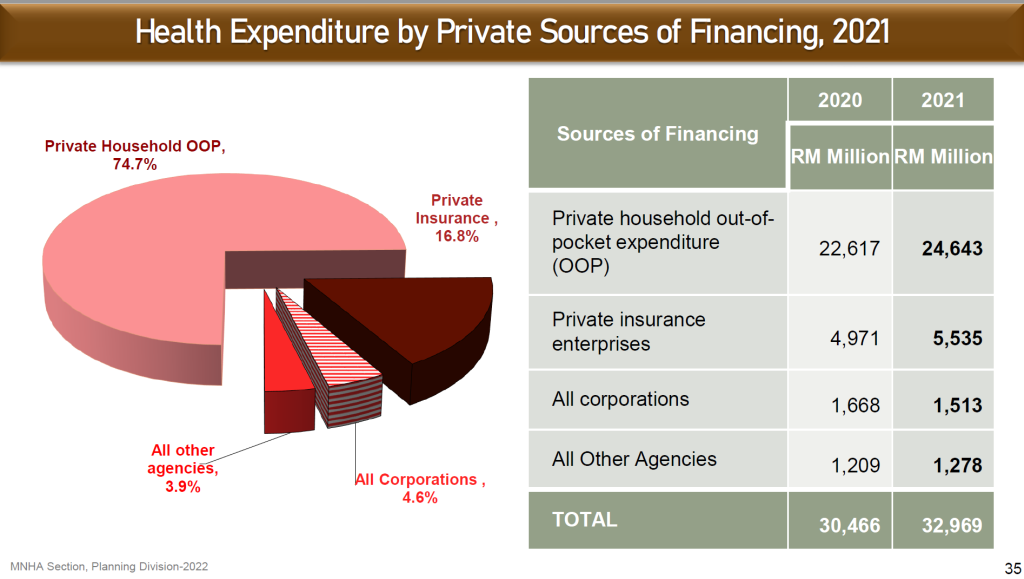
Health expenditure by private sources of financing in 2021. Graphic by MOH’s Malaysia National Health Accounts (MNHA) presentation on November 10, 2022.
Apart from private household OOP expenditure, which formed 75 per cent of private sources of financing in 2021, other private financing sources came from private insurance enterprises at RM5.5 billion (16.8 per cent of the total), all corporations at RM1.5 billion (4.6 per cent) and all other agencies at RM1.28 billion (3.9 per cent).
In total, health expenditure by private sources of financing in 2021 amounted to RM32.97 billion.
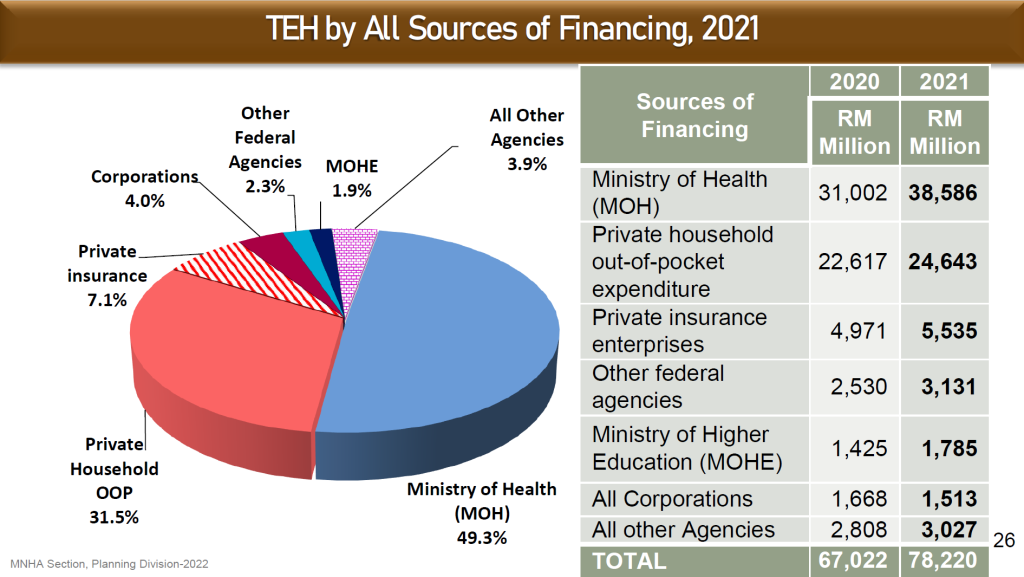
Total expenditure on health (TEH) by all sources of financing in 2021. Graphic by MOH’s Malaysia National Health Accounts (MNHA) presentation on November 10, 2022.
Overall, Malaysia spent a total of RM78.2 billion or RM2,401 per capita on health in 2021, which is equivalent to 5.1 per cent of the country’s gross domestic product (GDP).
About 57.9 per cent or RM45.2 billion of the funding came from the public sector and 42.1 per cent or RM32.96 billion came from the private sector. By percentage of GDP, public health expenditure made up 2.9 per cent of GDP, and private 2.13 per cent of GDP.
The Ministry of Health (MOH) is the biggest source of financing in 2021 at RM38.6 billion or 49.3 per cent of the total RM78.2 billion spent, followed by private OOP expenditure of RM24.6 billion (31.5 per cent), private insurance enterprises at RM5.5 billion (7.1 per cent), other federal agencies at RM3.1 billion (2.3 per cent) and the Ministry of Higher Education at RM1.8 billion (1.9 per cent).
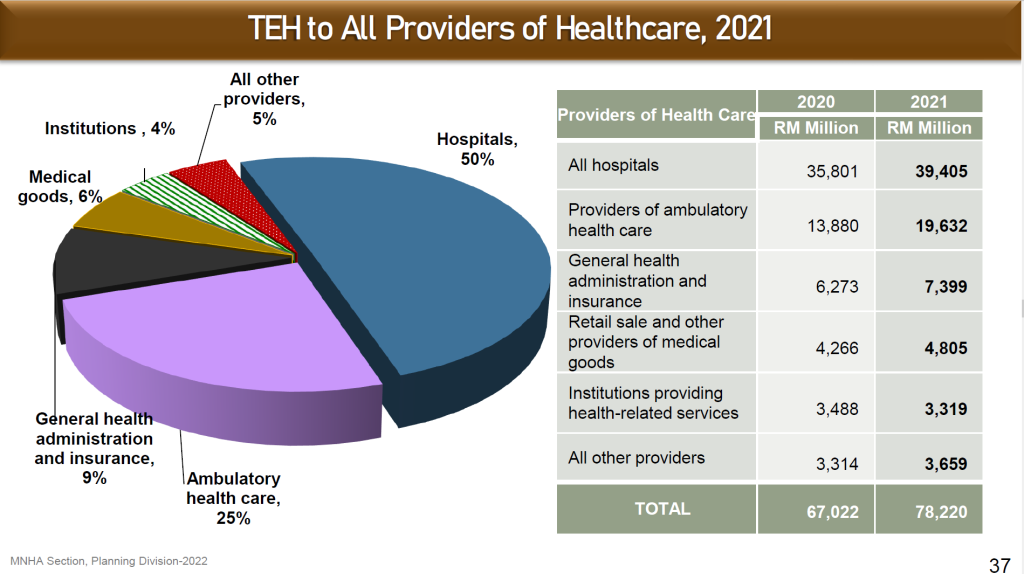
Total expenditure on health (TEH) to all providers of health care in 2021. Graphic by MOH’s Malaysia National Health Accounts (MNHA) presentation on November 10, 2022.
The biggest expenditure was on all hospitals at RM39.4 billion (50 per cent), followed by providers of ambulatory health care at RM19.63 billion (25 per cent) and general health administration and insurance at RM7.4 billion (9 per cent).
Retail sale and other providers of medical goods amounted to RM4.8 billion (6 per cent), while institutions providing health-related services totalled RM3.3 billion (4 per cent). Other providers amounted to RM3.6 billion or 5 per cent of the total expenditure on health.
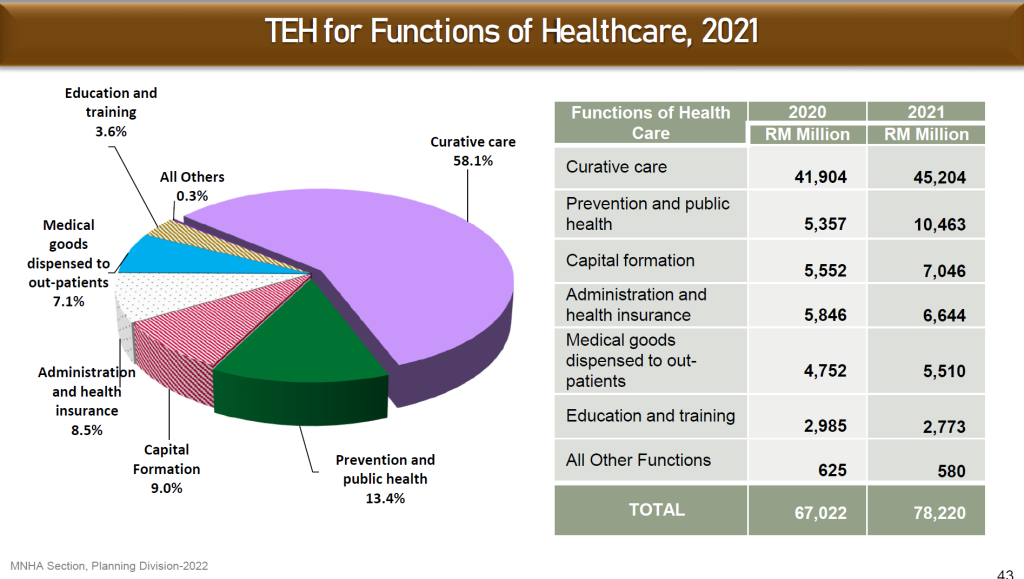
Total expenditure on health (TEH) for functions of health care in 2021. Graphic by MOH’s Malaysia National Health Accounts (MNHA) presentation on November 10, 2022.
In terms of expenditure on types of care, the highest spending in 2021 was on curative care at RM45.2 billion, followed by prevention and public health, which doubled year-on-year to RM10.46 billion, and capital formation at RM7.05 billion.
Administration and health insurance amounted to RM6.6 billion, followed by medical goods dispensed to patients at RM5.5 billion, education and training at RM2.77 billion, and all other functions at RM580 million.








